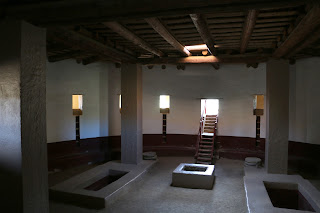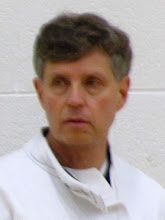Part 1 can be found here.
In the evening we decamped to a hotel in Farmington, New Mexico. A shower after three days of hiking and camping was more than good fun. We then gathered on a patio for drinks and to listen to Philip Tuwaletstiwa speak and read his paper, “Chaco Pathways.” I enjoyed the paper a lot, not least because he began with his visit to Maes Howe in the Orkney Islands, a Neolithic site Lynn and I recall fondly.
In the evening we decamped to a hotel in Farmington, New Mexico. A shower after three days of hiking and camping was more than good fun. We then gathered on a patio for drinks and to listen to Philip Tuwaletstiwa speak and read his paper, “Chaco Pathways.” I enjoyed the paper a lot, not least because he began with his visit to Maes Howe in the Orkney Islands, a Neolithic site Lynn and I recall fondly.
I would call
it a personal essay, a venerable literary form of which I’m particularly fond,
not least because of the way in which truly good ones deeply engage readers or
listeners, which his certainly did that evening.
Though he
began with the common properties of certain fundamental structures in very
diverse cultures (such as Maes Howe), his primary concern was identifying the
set of shared characteristics of human consciousness across cultures. He listed ten probable ones and it occurred
to me that such a set might not only explain the human will to spiritual
observance but also the human will to scientific definition and exploration as
well, which is wicked cool, when you think about it for a bit.
As if in
recognition of that point, he then turned to the particular concern of Chaco
roads and argued persuasively with statistical analysis and cultural context
that they are most probably spiritual pathways.
I particularly liked the way he illustrated how spiritual pathways can
hide in plain sight and his observation of people’s behavior at the entrance of
an evangelical church.
One of the
“shared characteristics of human consciousness” he mentioned was “an ongoing
struggle to bring order out of chaos.”
In that context he quoted a Diné song,
With beauty
may I walk.
With beauty before me may I walk.
With beauty behind me may I walk.
With beauty above me may I walk.
With beauty all around me may I walk.
With beauty before me may I walk.
With beauty behind me may I walk.
With beauty above me may I walk.
With beauty all around me may I walk.
It was both
precisely pertinent but also quietly brave.
And it led perfectly to the next shared characteristic, art. My synopsis of his paper doesn’t do adequate
service to its subject and I’ll refrain from quoting the insight of his
conclusion which deserves to be read in the context of the paper as a whole.
I will say
that I will be severely grumpy with him if he doesn’t publish it. Soon.
The next day
we set off for Aztec and then Chimney Rock.
One of the startling things about Aztec is its contemporary geographic
context: a great and amazing Chacoan
site resides in the middle of the north suburb sprawl of Farmington, New
Mexico. You pass through the Park
Service entrance in the shade of cottonwood trees and in a few steps you’re
immersed in the Chacoan world and one of its most exquisitely beautiful sites. Lekson argues this was Chacoan culture at its
peak and optimally efficient and capable.
The western great house was the largest edifice they ever constructed
and it was done so quickly, probably in about a decade (versus 300 years for
Pueblo Bonito), though still following the same empirical-architectural
paradigm.
Two things
engaged me particularly this visit, the Hubbard Tri-wall structure, a stone footprint
consisting of concentric circles linked with radial segments, and the great
kiva. The rooms of the Hubbard Tri-wall
structure would have been much too small for practical storage or habitation; I
couldn’t help but wonder if the Chacoans were buttressing to facilitate height
for tower construction, just as European medieval architects had used flying
buttresses in cathedral construction.
Then there was the great kiva, excavated and restored by Earl
Morris. I’ve always felt that Aztec Ruins
is probably the best place for someone to begin learning about Chacoan
culture. The restored kiva is a catalyst
for the imagination and experiencing it is one of the best ways to school your
ability to visualize what a Chacoan ruin looked like when they were first complete
and occupied. Lekson once again brought
the practice of archaeology to life, recounting Earl Morris’ excavation in the
1920s and his return to it in 1934 when he carefully restored it as part of a
WPA project for the National Park Service:
there is nothing in the reconstruction, including the unique pattern of
the roof structure, that wasn’t suggested by what he found during the original
excavation. So Earl Morris is now one of
my new heroes.
We finished
at Chimney Rock that afternoon. Much of
the discussion concerned astronomical alignments and Philp gave a nice recap of
the work of Anna Sofaer and the Solstice Project before we walked up to the
great house, which is adjacent to the two great stone pillars. The views from there are excellent, of
course, and it is nothing if not a
statement of imperial Chaco culture given the labor required to build and
maintain such a structure on a peak. (I’m
sure I was one of the water carriers in a former short life.) The remains of
the formal fire pit at the north end of the point and the view of Huerfano Peak
which served as the intermediate signal station between Chaco and the Chimney
Rock community is one of the most dramatic examples of the Chacoan
communication system. It was first identified
by Tom Windes, who argued it may have had more importance than the road system
to the function of the extended culture as a whole.
I’ve always
felt that astronomical alignments are difficult because they constitute a
spectrum: from those of clear practical
use, such as soltitial markers which are useful, even essential, for
agriculture to those with ritual importance to those which may have occurred by
chance. So interpreting them is difficult
and obviously many are ambiguous. An
impartial, multi-cultural classification system would be a very useful thing. Each class should have a set of clear,
objective defining criteria, such as practicality for agriculture and/or
ethnographic references etc.. Devising
such a system would be non-trivial to be sure and devising it or collecting the
right set of people to do so would require intellectual depth in multiple
sciences and cultures. The great benefit
would be the collective data analysis and discoveries it might facilitate, not
to mention moving many conversations about them to a more productive
place. With all do deference, I’d
suggest Phillip Tuwaletstiwa is uniquely qualified to lead such an undertaking.
Our little
expedition concluded appropriately with dinner and farewells at a good
restaurant in Durango. Though I haven’t
mentioned them in the preceding I must thank David Boyle and Peggy Zemach, the
other members of the Crow Canyon team for their diligence as well. They managed sometimes complicated logistics
and inevitable surprises with remarkable efficiency and aplomb. Most importantly, I owe thanks to the
group as a whole for so many engaging and inspiring conversations, from an
improbably cheerful before coffee conversation with Charlie Leffingwell about
mummy sleeping bag techniques to avoid boa constrictor dreams, to a
conversation with Phillip and Steve about the literality of Hopi and Navajo
ethnography and oral tradition. Then
there was the afternoon when Susan Markley shared her amazing photos of Eric
Clapton in concert. All were great fun.
A few
closing comments on the trip. I ‘ve
lived in the Southwest U.S. much of my life.
It has a much more remarkable history and prehistory than most people
know and both are particularly pertinent to the challenges our society and
multiple cultures now face. I feel have
a right to know my home’s history and prehistory and an obligation as well.
If, by
chance, you’re just beginning a journey in Southwest prehistory and
archaeology, I highly recommend the new revision of The Chaco Meridian as an entrance.
It’s way too much fun for the amount of hard and clear scholarship it
delivers. Stephen Lekson’s writing is
effortlessly engaging but his observations and assertions were forged by years
of field work and excavations, careful
critical analysis and peer review. Perhaps
most importantly, without apparent effort and editorializing it conveys the great
significance of the subject and work.
And when you’ve finished that you can move on to A History of the Ancient Southwest, his bicameral comprehensive history of the ancient southwest and the history of the people, international politics, academic fashions and cultural changes and conflicts which shaped the archaeology from which he assembled and deduced his history of the pre-history. At the “Big MACC” Conference this spring I observed that his fundamental premises, that “everyone knew everything,” that “there were no coincidences,” that “distances can be dealt with” now informs and shapes much new work and I expect it to continue to do so for a long time to come.
(The
concluding Pueblo Bonito sunset photos are from a previous trip. Now back to Malory and other concerns.)












No comments:
Post a Comment